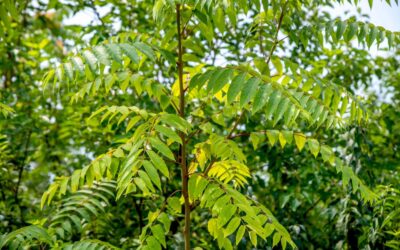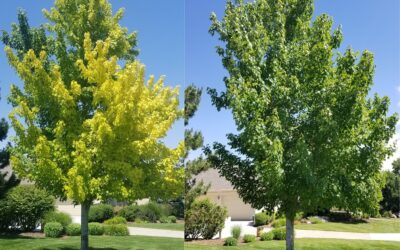Also known as the Netleaf Hackberry, Sugarberry or Paloblanco, the Western Hackberry is a large shade tree that’s well suited for urban areas. It’s deep-rooted when mature making it wind-resistant, drought-tolerant and tolerant of alkaline soils. Its deep roots also make it a good choice for planting near pavement since they don’t raise the soil around the tree, preventing cracking of concrete and asphalt.
Flowers, Fruit, Foliage and Hardiness
The Hackberry is a deciduous tree native to Colorado with dark green oval leaves about 2″ wide and 4″ long that taper to a sharp point at their tips. It produces small, inconspicuous greenish flowers in early spring and small orange-red fruit that attracts birds in late summer and early fall. The leaves turn yellow in the fall before dropping. It withstands Colorado winters well with a hardiness rating up to Zone 9 and 7,500-foot elevations.
Where to Plant
Plant Western Hackberry trees to add shade and character to landscapes. Keep them at least 12 feet from structures to allow for growth—mature trees grow to 25-50 feet tall with a dense, rounded canopy about as wide. Young trees need moist soil to start, but grow relatively quickly with deep roots that don’t need a lot of water once established. Young trees can also grow branches irregularly, so frequent pruning is recommended to encourage an attractive central trunk shape and canopy.
Disease-Resistant and Wild
Western Hackberries are relatively disease-resistant and are excellent alternatives to elm trees, which are more delicate. They’re resistant to root fungus and the only significant insect problem is an occasional aphid attack. These sturdy trees grow naturally along streambanks and are frequently planted in rural areas as windbreaks and as wildlife habitat. Their strong trunks are often used as fence posts and for firewood.
If you’re planning to add a Western Hackberry to your landscape, or have one that needs maintenance, Donovan Arborists offers complete tree care and planting services in the greater Denver area. Locally owned and environmentally mindful, we provide the expert care you need. Call Paul to learn more at 303-623-8733.



